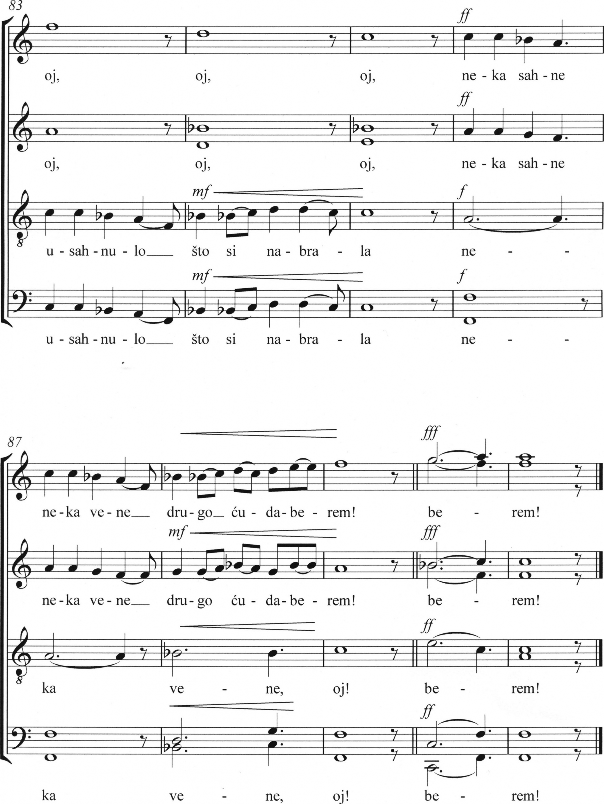

Revista Música Hodie, Goiânia - V.15, 273p., n.2, 2015
Slađana Marić (Faculty of Philosophy University of Novi Sad, Novi Sad, Sérvia)
The choral piece “Rukovet No.1” for choir (SATB) by Slađana Marić presents a mo- destpersonal attempt to honorthe choral compositional tradition of Serbian composer Ste- van Stojanović Mokranjac1 (1856-1914), regarding the anniversary of 160 years from his birth in 2016. He was the most important figure of Serbian musical romanticism during which the quality of certain choirs was recognized on the international scene. Mokranjac composedfifteen choral suites or rhapsodies of gathered and arranged traditional songs to which he gave the name “Rukoveti” (“Garlands” or “Song-Wreaths”). The basic principles of Mokranjac, and in this case of Marić, while composing her firstrukovet, were the follo- wing: (1) choosing short songs of high standards of quality (melodies with lyrics); (2) grou- ping songs by similarity of content or the region they come from; (3) songs gathered and ar- ranged as a rukovet on the basis of other cyclic form, such as suite and sonata, are different in mood, character and tempo, but at the end make one solid unit; (4) traditional melodies are not changed, they are artisticallytreated with applying polyphony and counterpoint; (5) special attention is paid to the psychologicalconnections of words and music: making dia- logs between, for e.g., male and female choir, solo and choir, etc.
Therefore, the “Rukovet No.1”, by Slađana Marić is a secular choral a capella com- position for four voices (SATB), highly inspired by Mokranjac’s creative interpretation of folk tunes. This music piece is based on four short Southern Serbian traditional melodies or songs with traditional lyrics different in mood, character and tempo, arranged into a single unit, artistically treated with applying both vocal homophony and polyphony.Performers are expected to have experience in singing polyphony and a wide range of voices, although further adaptations of lowest or highest notes are acceptable.The main obstacles in perfor- ming this piece to many performers may be the language (especially the letters š, ć, and đ, and their sounds)and the traditional lyrics, thus, by providing the translation and the pho- netic chartin English, the composer encourages all performers to explore their possibilities and enjoy performing this vocal piece.
1 The contribution and work of Mokranjac as a choral conductor, composer, melographer, ethnographer and other, are covered in detail inmany publications. For general information in English we recommend the official pa- ge titled Mokranjčeva Zadužbina / The Mokranjac Foundation (http://www.mokranjcevazaduzbina.org/eng/o_ stevanu_st_mokranjcu.html) and articles by musicologists Moody, Đaković, Arnautović, Milanovićand Ribić, all in the musicological journal New Sound, issues 43, available at: http://www.newsound.org.rs/en/magazines/ newsound43.html, also an article by Tomašević, K. (2010)Stevan Stojanović Mokranjac and the inventing of tradition: a case study of the Song ‘Cvekje Cafnalo’, in Musicological Annual, v.46, No.1, p. 37-56,available at: http://revije.ff.uni-lj.si/MuzikoloskiZbornik/article/viewFile/2438/2124.
Revista Música Hodie, Goiânia - V.15, 273p., n.2, 2015 Recebido em: 14/08/2015 - Aprovado em: 10/11/2015
![]()
Slađana Marić - music pedagogue, pianist, coloratura soprano and composer. She graduated in two different sub- ject areas: 1) Music Pedagogy at The Academy of Arts – University of Novi Sad (2007-2011), and in 2) English Lan- guage Philology at “The Faculty of Legal and Business Studies Lazar Vrkatić, PhD” in Novi Sad (2012). At The As- sociation of Centres for Interdisciplinary and Multidisciplinary Studies and Research (ACIMSI) of The University of Novi Sad (UNS) (in 2013), Marić finished her postgraduate master studies in Management in Education. She is cur- rently a student of a doctoral study programme in Teaching Methodology at the Faculty of Philosophy (UNS). She has a working experience in Music School “Isidor Bajić” as a teacher of different music subjects and English lan- guage, and in both Primary and Secondary Ballet School as a piano accompanist of classical ballet classes and a teacher of Solfeggio, Music Culture and History of Music.
![]()











